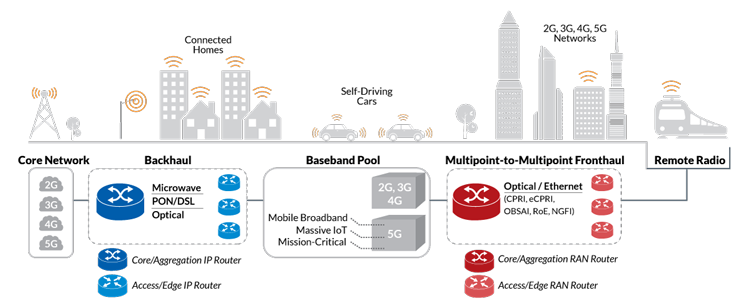Opening up the road to 5G by redesigning the fronthaul
5G is more than a new generation of technologies. It marks an inflection point for how we connect with the world today. It also promises instantaneous, high-speed data access to billions of users, devices, machines, buildings, and cities – each placing new demands on mobile infrastructure and sparking the need for a change in its design, starting with the Radio Access Network (RAN).
To provide the different levels of performance, spectrum, latency, and power that various applications require, 5G disaggregates the RAN into different functions and employs a flexible, service-oriented protocol stack with centralized network control. Because of this, fronthaul, or the connection between these functions in the RAN, has become a critical component in delivering the vision of 5G we’ve been promised. Yet the current closed, proprietary, and point-to-point approach to managing the fronthaul network threatens this.
Making the industry’s vision of 5G a reality
To achieve the true benefits of 5G, the fronthaul network must also undergo significant transformation, as a multipoint-to-multipoint fronthaul network driven by software is needed. This approach lets any baseband modules be connected to any remote radio units, regardless of vendor, and over any protocol interface, thereby creating an environment where an interoperable and open Radio Access Network (RAN) can become a reality.
Here, network resources can be dynamically routed to any remote radio units in the coverage area, supporting demands of the Internet of Things (IoT), mission-critical applications, and the many other bandwidth intensive applications that 5G will deliver – analogous to how IP data packets are routed in the backhaul (Figure 1).

Figure 1. A multipoint-to-multipoint fronthaul network enables routing of baseband resources to any remote radio units. This is analogous to how IP data packets are routed in the backhaul.
Yet this is just one piece of the puzzle. To drive greater efficiency and cost savings, not only will 5G leverage functions disaggregation, it will also take advantage of RAN virtualisation and Software-Defined Networking (SDN). The greatest advantages of virtualization, though, can only be realized once the virtualization is end-to-end; not just covering the base stations of the network, but extending this across the fronthaul to include network radio resources.
A 5G ready fronthaul network, therefore, must be able to support the virtualisation of certain network functions such as aggregation and routing. Base stations resources can then be remotely configured using software, and allocation can be dynamic and elastic. This means the network components that traditionally reside within dedicated hardware can be easily pooled, shared, and accessed, then routed to any destination point – which will be fundamental to the success of 5G.
Looking forward, while enhancing what’s come before
Mobile operators globally have been working with network equipment vendors on various 5G trials in anticipation of the widespread availability in 2020. With the first 3GPP 5G NR specifications approved in late 2017, and first-tier mobile operators promising 5G networks by the end of 2018, 5G is gaining much more momentum and quickly becoming a reality. However, the benefits of evolving the fronthaul network extend beyond this new technology.
While future-proofing and modernizing the networks in preparation for 5G are important, having the ability to support legacy 2G, 3G, and 4G networks is also vital. After all, operators have invested billions into their existing infrastructure and therefore need to find cost-effective ways to modernize their networks that will continue to carry the weight of traffic.
A 5G ready fronthaul must also be able to support current protocols, such as CPRI, and other key protocols such as eCPRI, Radio over Ethernet (RoE), and Next Generation Fronthaul Interface (NGFI), as well as providing the flexibility to connect any baseband module to any remote radio unit. This will ensure backward compatibility and preserve the mobile operators’ capital expenditure.
The next-gen fronthaul network
It’s clear that a truly digital and connected society will become a reality with the promises of 5G. However, as the broad scope of applications to be enabled by 5G has grown, so too has the need for flexible network architecture. An evolved fronthaul network, based on interoperable interfaces and designed to support multiple protocols, technologies, vendors, and operators is imperative. This will not only ensure that mobile operators have a 5G ready network but a network that can support legacy 2G, 3G and 4G infrastructures too.

